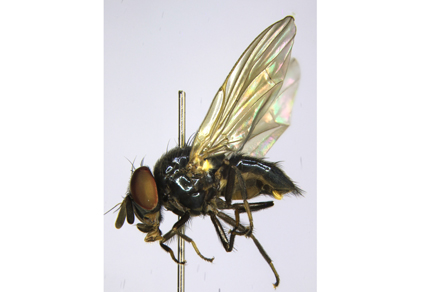Abstract
A distinctive species of Neosilba Waddill & Weems, namely Neosilba flavitarsis sp. nov is described from specimens reared from cultivated figs in Mexico. DNA sequencing confirms that the species belongs in the genus Neosilba and it is placed in a phylogenetic tree with other close relatives.
References
- Benson, D.A., Cavanaugh, M., Clark, K., Karsch-Mizrachi, I., Lipman, D.J., Ostell, J. & Sayers, E.W. (2017) GenBank. Nucleic Acids Research, 45, D37–D42. https://doi.org/10.1093/nar/gkw1070
- Darriba, D., Taboada, G.L., Doallo, R. & Posada, D. (2012) jModelTest 2: more models, new heuristics and parallel computing. Nature Methods, 9, 772–772. https://doi.org/10.1038/nmeth.2109
- Edler, D., Klein, J., Antonelli, A. & Silvestro, D. (2020) raxmlGUI 2.0: A graphical interface and toolkit for phylogenetic analyses using RAxML. Methods in Ecology and Evolution, 12 (2), 373–377. https://doi.org/10.1111/2041-210X.13512
- Galeano-Olaya, P.E. & Canal, N.A. (2012) New species of Neosilba McAlpine (Diptera: Lonchaeidae) and new records from Colombia. Papéis Avulsos de Zoologia, 52 (31), 361–385. https://doi.org/10.1590/S0031-10492012021100001
- Hall, T.A. (1999) BioEdit: a user-friendly biological sequence alignment editor and analysis program for Windows 95/98/NT. Nucleic Acids Symposium Series, 41, 95–98
- Katoh, K., Rozewicki, J. & Yamada, K.D. (2019) MAFFT online service: multiple sequence alignment, interactive sequence choice and visualization. Briefings in Bioinformatics, 20 (4), 1160–1166. https://doi.org/10.1093/bib/bbx108
- Kumar, S., Stecher, G. & Tamura, K. (2016) MEGA7: Molecular Evolutionary Genetics Analysis version 7.0 for bigger datasets. Molecular Biology and Evolution, 33, 1870–1874. https://doi.org/10.1093/molbev/msw054
- MacGowan, I. (2015) A review of the Silba admirabilis McAlpine species group (Diptera: Lonchaeidae) with descriptions of thirteen new species from the Afrotropical region. Zootaxa, 4032 (5), 515–534. https://doi.org/10.11646/zootaxa.4032.5.3
- MacGowan, I. (2023) World Catalogue of the family Lonchaeidae (Diptera, Cyclorrhapha, Acalyptratae). Zootaxa, 5307 (1), 1–96. https://doi.org/10.11646/zootaxa.5307.1.1
- MacGowan, I. & Rotheray, G.E. (2021) Lonchaeidae (lance flies). In: Kirk-Spriggs, A.H. & Sinclair, B.J. (Eds), Manual of Afrotropical Diptera. Vol. 3. Brachycera–Cyclorrhapha, excluding Calyptratae. Suricata. Vol. 8. South African National Biodiversity Institute, Pretoria, pp. 1587–1596. [https://www.nhm.ac.uk/our-science/our-work/biodiversity/manual-afrotropical-diptera.html]
- McAlpine, J.F. & Steyskal, G.C. (1982) A revision of Neosilba McAlpine with a key to the world genera of Lonchaeidae. Canadian Entomologist, 114 (2), 105–137. https://doi.org/10.4039/Ent114105-2
- Rambaut, A. (2016) FigTree. Version 1.4.3. Institute of Evolutionary Biology, University of Edinburgh. [software]
- Ronquist, F., Teslenko, M., van der Mark, P., Ayres, D.L., Darling, A., Höhna, S., Larget, B., Liu, L., Suchard, M.A. & Huelsenbeck, J.P. (2012) MrBayes 3.2: efficient Bayesian phylogenetic inference and model choice across a large model space. Systematic Biology, 61, 539–542. https://doi.org/10.1093/sysbio/sys029
- Simon, C., Frati, F., Beckenbach, A., Crespi, B., Liu, H. & Flook, P. (1994) Evolution, weighting, and phylogenetic utility of mitochondrial gene sequences and a compilation of conserved polymerase chain reaction primers. Annals of the Entomological Society of America, 87 (6), 651–701. https://doi.org/10.1093/aesa/87.6.651
- Sousa, de E.M., Louzeiro, L.R.F., Strikis, P.C., Souza-Filho, M.F. & Raga, A. (2021) Host plants and distribution records of lance flies (Diptera: Lonchaeidae) in São Paulo State, Brazil. EntomoBrasilis, 14, 942–942. https://doi.org/10.12741/ebrasilis.v14.e942
- Urrutia, F.M. (2004) Revisión taxonómica parcial del género Neosilba McAlpine (Diptera: Lonchaeidae) em la región Neotropical. Unpublished Master’s thesis, Universidad de Panamá, Panama City, 146 pp. [https://up-rid.up.ac.pa/4091/3/flor_urrutia.pdf]
- Zhang, Z., Schwartz, S., Wagner, L. & Miller, W. (2000) A greedy algorithm for aligning DNA sequences. Journal of Computational Biology, 7 (1–2), 203–214. https://doi.org/10.1089/10665270050081478


